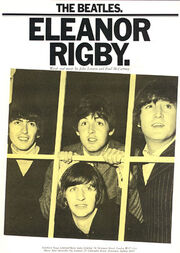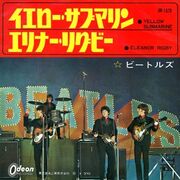| Eleanor Rigby | |
| Released | August 5, 1966 |
| A-Side | Yellow Submarine |
| Genre | Baroque Pop |
| Length | 2:06 |
| Single Guide | |
| previous Yellow Submarine |
next Strawberry Fields Forever |
Eleanor Rigby is a song by The Beatles, originally released on the 1966 album Revolver. The song was primarily written by Paul McCartney, although John Lennon claimed that "the first verse was his and the rest are basically mine."

UK Promotional Poster.
Pete Shotton, a close friend of Lennon who was present at the time, said "Though John (whose memory could be extremely erratic) was to take credit, in one of his last interviews, for most of the lyrics, my own recollection is that 'Eleanor Rigby' was one 'Lennon-McCartney' classic in which John's contribution was virtually nil." McCartney also says that Lennon helped on about "half a line." It remains one of The Beatles' most recognizable and unique songs, with a double string quartet arrangement by George Martin, and striking lyrics about loneliness. The song continued the transformation of the group, started in Rubber Soul, from a mainly pop-oriented act to a more serious and experimental studio band. It appeared in the Yellow Submarine animated movie. Later Paul McCartney released a second version with some parts added on as well as a mostly instrumental song,"Eleanor's Dream."
Inspiration
As is true of many of McCartney's songs, the melody and first line of the song came to him as he was playing around on his piano. The name that came to him, though, was not Eleanor Rigby but Miss Daisy Hawkins. In 1966, McCartney recalled how he got the idea for his song:
“ I was sitting at the piano when I thought of it. The first few bars just came to me, and I got this name in my head... 'Daisy Hawkins picks up the rice in the church'. I don't know why. I couldn't think of much more so I put it away for a day. Then the name Father McCartney came to me, and all the lonely people. But I thought that people would think it was supposed to be about my Dad sitting knitting his socks. Dad's a happy lad. So I went through the telephone book and I got the name McKenzie. ”
Others believe that Father McKenzie refers to 'Father' Tommy McKenzie, who was the compere at Northwich Memorial Hall.
McCartney originally imagined Daisy as a young girl, but anyone who cleaned up in churches would probably be older. If she were older, she might have missed not only the wedding she cleans up after but also her own. McCartney said he came up with the name Eleanor from actress Eleanor Bron, who had starred with the Beatles in the film "Help!". Rigby came from the name of a store in Bristol, Rigby & Evens Ltd, Wine & Spirit Shippers, that he noticed while seeing his then-girlfriend Jane Asher act in The Happiest Days Of Your Life. He recalled in 1984, "I just liked the name. I was looking for a name that sounded natural. Eleanor Rigby sounded natural."In the 1980s, a grave of an Eleanor Rigby was discovered in the graveyard of St. Peter's Parish Church in Woolton, Liverpool, and a few yards away from that, another tombstone with the last name McKenzie scrawled across it. During their teenage years, McCartney and Lennon spent time "sunbathing" there; within earshot distance of where the two had met for the first time during a fete in 1957. Many years later McCartney stated that the strange coincidence between reality and lyric could be a product of his subconscious, rather than being a meaningless fluke. The actual Eleanor Rigby was born in 1895 and lived in Liverpool, possibly in the suburb of Woolton, where she married a man named Thomas Woods. She died on 10 October 1939 at age 44, which, because 1940 was a leap year, was exactly one year to the day before Lennon was born. Whether this Eleanor was the inspiration for the song or not, her tombstone has become a landmark to Beatles fans visiting Liverpool. A digitized version was added to the 1995 music video for the Beatles' reunion song "Free as a Bird".

Japanese Cover
The Beatles finished off the song in the music room of John Lennon's home at Kenwood. John Lennon, George Harrison, Ringo Starr, and their friend Pete Shotton all listened to McCartney play his song through and contributed ideas. Someone suggested introducing a romance into the story, but this was rejected because it made the story too complicated. Starr contributed the line "writing the words of a sermon that no one will hear " and suggested making "Father McCartney" darn his socks, which McCartney liked, and Harrison came up with the line "Ah, look at all the lonely people". Shotton then suggested that McCartney change the name of the priest, in case listeners mistook the fictional character in the song for McCartney's own father. McCartney couldn't decide how to end the song, and Shotton finally suggested that the two lonely people come together too late as Father McKenzie conducts Eleanor Rigby's funeral. At the time, Lennon rejected the idea out of hand, but McCartney said nothing and used the idea to finish off the song, later acknowledging Shotton's help.
Credits
- Paul McCartney - Lead and Harmony Vocals
- John Lennon - Harmony Vocals
- George Harrison - Harmony Vocals
- Tony Gilbert - Violin
- Sidney Sax - Violin
- John Sharpe - Violin
- Jurgen Hess -Violin
- Stephen Shingles - Viola
- John Underwood - Viola
- Derek Simpson - Cello
- Norman Jones - Cello
- Peter Halling-Cello

